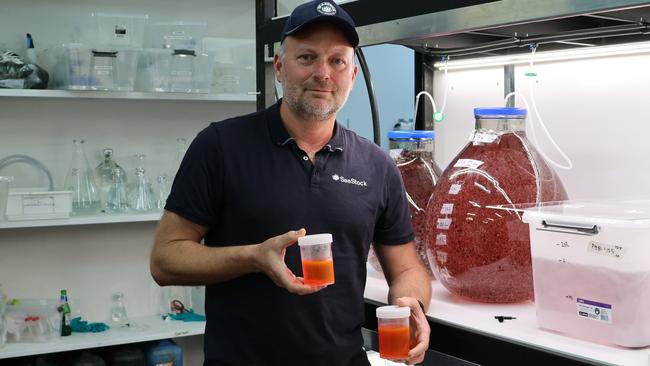SeaStock patents unique approach to asparagopsis seaweed production
Governments and companies around the world are cracking down on carbon emissions in their supply chain. A Fremantle business has come up with a solution for the livestock sector.

The fluffy red dots swirling in vials and giant tubes in Tom Puddy’s Fremantle production facility represent the great hope for the global livestock industry.
It’s a native seaweed, asparagopsis, and when fed to cattle and sheep it can reduce their methane emissions by up to 90 per cent.
Given that livestock account for about 15 per cent of global carbon emissions, mostly through the methane they burp, and with governments around the world starting to tax farmers for that methane they emit, it’s a problem in need of a solution.
The jars in Mr Puddy carries, one a fluorescent pink, the other a dark yellow, signify the unique approach his company, SeaStock, has taken to making that hope an economic reality.
Mr Puddy, who will be a panellist at The Australian’s Bush Summit in Port Hedland on Friday, hopes it will enable consumers to keep eating meat and dairy products without worrying about their impact on emissions.

“If we can adopt this on a global scale, that means there’s a great opportunity to reduce global greenhouse gas emissions en masse by reducing the methane that livestock expel,” Mr Puddy said.
“We can help the industry become more sustainable.”
In the yellow jar is canola oil mixed with bromoform extracted from the seaweed through a patented process.
The oil mixture enables preservation of the bromoform chemical behind the methane reduction, and easy transportation to budding customers around the world.
In the pink jar is pigment extracted from the seaweed that food and cosmetic companies are coveting for use as a natural dye.


The value in the dye has solved one of the key conundrums facing the fledgling asparagopsis sector: how to make it cost-effective for farmers to feed to their stock.
It means farmers or lot feeders pay only 40c a day per unit, down from more than $1. It also boosts the ability for stock to gain weight and enables producers to cover the cost by acquiring carbon credits from using the seaweed.
While Australia is yet to approve a carbon credit method for the product, it’s already an option in Europe.
SeaStock last week announced the first commercial sale of its asparagopsis oil and is progressing plans to expand its production facility in Western Australia.
Mr Puddy is preparing to supply the oil to farmers in carbon-conscious European countries such as Denmark, where the government has brought in a methane tax for the industry.
“Global brands are under pressure from their shareholders, customers and governments to reduce emissions across their supply chains,” he said.
“Depending on which country you’re in, they have different mandates on how to reduce but most companies now are adopting ESG (environment, social and governance) strategies going forward.”

Australia became a signatory to the Global Methane Pledge in 2022, which aims to reduce methane emissions by 30 per cent by 2030.
While the Albanese government has ruled out a New Zealand-style burp tax, the red meat and dairy industries in Australia are eager to avoid being locked out of valuable markets.
SeaStock is one of five companies in Australia and New Zealand licensed by CSIRO-owned FutureFeed to sell asparagopsis products for methane reduction, but its bromoform and pigment extraction methods are what set it apart.

Another conundrum for the asparagopsis sector is how to enable farmers to disperse it among their stock in large-scale rangeland operations like those found throughout much of Australia.
Where dairy cattle and animals in feedlots can be hand-fed daily, it’s not a practical solution in the massive properties in the bush.
SeaStock’s solution can be mixed into lick blocks accessed by cattle, or through a bolus that breaks down in their stomachs over several months.







To join the conversation, please log in. Don't have an account? Register
Join the conversation, you are commenting as Logout